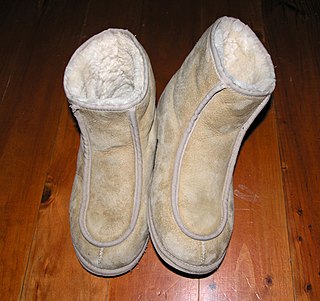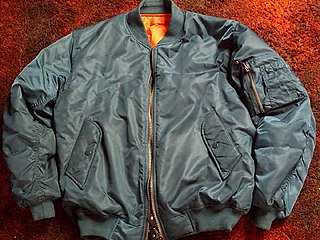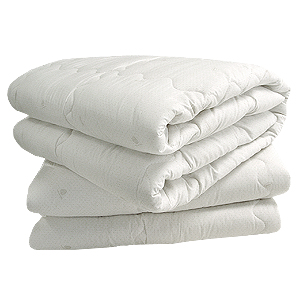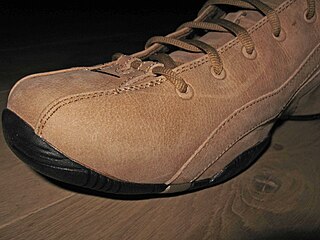
Tahrs or tehrs are large artiodactyl ungulates related to goats and sheep. There are three species, all native to Asia. Previously thought to be closely related to each other and placed in a single genus, Hemitragus, genetic studies have since proven that they are not so closely related and they are now considered as members of three separate monotypic genera: Hemitragus is now reserved for the Himalayan tahr, Nilgiritragus for the Nilgiri tahr, and Arabitragus for the Arabian tahr.

A parka or anorak is a type of coat with a hood, often lined with fur or faux fur. This kind of garment is a staple of Inuit clothing, traditionally made from caribou or seal skin, for hunting and kayaking in the frigid Arctic. Some Inuit anoraks require regular coating with fish oil to retain their water resistance.

Suede is a type of leather with a fuzzy, napped finish, commonly used for jackets, shoes, fabrics, purses, furniture, and other items. The term comes from the French gants de Suède, which literally means "gloves from Sweden". The term was first used by The Oxford English Dictionary in 1884.

Tahini or tahina is a Middle Eastern condiment made from toasted ground hulled sesame. It is served by itself or as a major ingredient in hummus, baba ghanoush, and halva.

Moleskin is a heavy cotton fabric, woven and then shorn to create a short, soft pile on one side. The feel and appearance of its nap is suede-like, less plush than velour and more like felt or chamois. The word is also used for clothing made from this fabric. Clothing made from moleskin is noted for its softness and durability. Some variants of the cloth are so densely woven as to be windproof.

Microfiber is synthetic fiber finer than one denier or decitex/thread, having a diameter of less than ten micrometers.

Ugg boots are a unisex style of sheepskin boot originating in Australia. The boots are typically made of twin-faced sheepskin with fleece on the inside, a tanned outer surface and a synthetic sole. The term "ugg boots" originated in Australia, initially for utilitarian footwear worn for warmth, and which were often worn by surfers during the 1960s. In the 1970s, the boots were introduced to the surf culture of the United Kingdom and the United States. Sheepskin boots became a fashion trend in the U.S. in the late 1990s and a worldwide trend in the mid-2000s. In Australia, they are worn predominantly as slippers and often associated with daggy fashion sense and bogan culture.

Flannel is a soft woven fabric, of varying fineness. Flannel was originally made from carded wool or worsted yarn, but is now often made from either wool, cotton, or synthetic fiber. Flannel is commonly used to make tartan clothing, blankets, bed sheets, and sleepwear.

A flight jacket is a casual jacket that was originally created for pilots and eventually became part of popular culture and apparel. It has evolved into various styles and silhouettes, including the "letterman" jacket and the fashionable "bomber" jacket that is known today.

A comforter, also known as a doona in Australian English, or a continental quilt or duvet in British English, is a type of bedding made of two lengths of fabric or covering sewn together and filled with insulative materials for warmth, traditionally down or feathers, wool or cotton batting, silk, or polyester and other down alternative fibers. Like quilts, comforters are generally laid over a top bed sheet and used to cover the body during sleep. Duvets are another form of quilt, traditionally filled with feathers, though since the late 20th century often made of synthetic fibres or down alternatives.

Granodiorite is a coarse-grained (phaneritic) intrusive igneous rock similar to granite, but containing more plagioclase feldspar than orthoclase feldspar.

The eaves are the edges of the roof which overhang the face of a wall and, normally, project beyond the side of a building. The eaves form an overhang to throw water clear of the walls and may be highly decorated as part of an architectural style, such as the Chinese dougong bracket systems.

Fur clothing is clothing made from the preserved skins of mammals. Fur is one of the oldest forms of clothing and is thought to have been widely used by people for at least 120,000 years. The term 'fur' is often used to refer to a specific item of clothing such as a coat, wrap, or shawl made from the fur of animals.

Sheepskin is the hide of a sheep, sometimes also called lambskin. Unlike common leather, sheepskin is tanned with the fleece intact, as in a pelt.

Lexico was a dictionary website that provided a collection of English and Spanish dictionaries produced by Oxford University Press (OUP), the publishing house of the University of Oxford. While the dictionary content on Lexico came from OUP, this website was operated by Dictionary.com, whose eponymous website hosts dictionaries by other publishers such as Random House. The website was closed and redirected to Dictionary.com on 26 August 2022.

Nubuck is top-grain leather that has been sanded or buffed on the grain side, or outside, to give a slight nap of short protein fibers, producing a velvet-like surface. It is resistant to wear, and may be white or coloured.

A malleolus is the bony prominence on each side of the human ankle.

Ultrasuede is the trade name for a synthetic ultra-microfiber fabric invented in 1970 by Dr. Miyoshi Okamoto, a scientist working for Toray Industries. In Japan, it is sold under the brand name Ecsaine. It is often described as an artificial substitute for suede leather. The fabric is multifunctional: it is used in fashion, interior decorating, automobile and other vehicle upholstery, and industrial applications, such as protective fabric for electronic equipment. It is also a very popular fabric in the manufacture of footbags and juggling balls. Other manufacturers such as Sensuede and Majilite also produce similar product lines of synthetic microfiber suede.

Shearling coats are made from processed lambskin, sheepskin, or pelt. This "shearing" process creates a uniform depth of the wool fibers for a uniform feel and look. Shearling coats and garments are made from pelts by tanning them with the wool of uniform depth still on them. The result is a soft, natural fleece material that is heavy due to thickness of outer skin and degree of fur on the inside, which is quite dense. The length of the sheep fur can be fairly long, but it is typically cropped short to about five centimetres or two inches. Most find these coats to be extremely comfortable and warm. Due to the high quality and uniqueness of shearling, coats and garment are considered luxurious. Sheepskin and Shearling are synonymous. The outer must be sheepskin to be Shearling on the inside.

A car coat is an outer garment originally made to be worn by automobile drivers and passengers. First designed to provide maximum warmth and coverage, over time it became a much shorter garment. Today it describes a coat that typically ends at mid thigh. It is worn by both men and women.






















